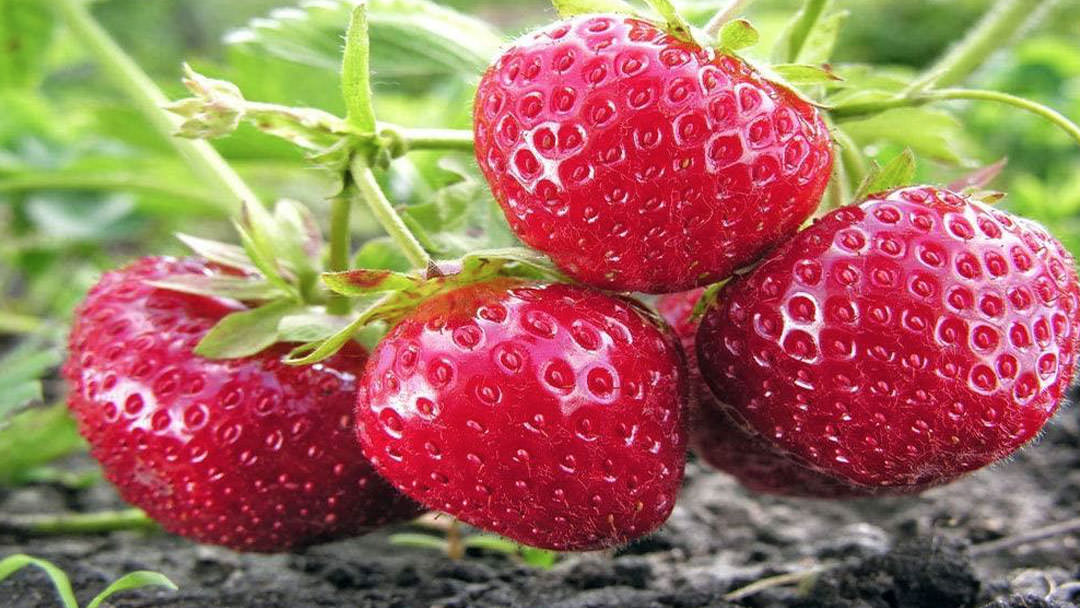The most common way to start a strawberry patch is to purchase bare-rooted plants, but starting from seed is more economical and can be much more rewarding. Strawberries are perennial plants and can be started from seed much like any other perennial.
There are 4 main types of strawberries, categized by how they bloom (when they produce fruit):
June Baring type: These varieties produce one very large crop, often of very large, firm berries for about 2-3 weeks in June. Then they switch to producing ‘runners. Best for processing.
Ever Baring type: These varieties produce a modest crop of slightly smaller berries from June until frost. They pause when temperatures are over 80°.
Day-Neutral type: These varieties produce 3 crops per season; June, Mid-July and Mid-August of medium sized very dense sweet fruit.
Native Type: Often called alpine, wild or Fraises de Boise. These are smaller fruits, often very sweet that bare mostly in June. They also make a great ground

The seeds you see on the outside of a strawberry “fruit” are really an “achene” with the true seed inside. Like the seeds of many perennials, strawberry seeds need to be stratified to initiate germination. Most strawberry seeds have been ‘pre-chilled’ before you purchase them. If you are not sure if your seeds have been preconditioned, you can place the seeds (still in the packet) in a sealed plastic bag or canning jar and place it in the back of your refrigerator for 10 days to 4 weeks. Allow the seeds to come to room temperature before you open the container. Sow the seeds on the surface of pre-moistened seed starting mix in trays and lightly press the seeds into the soil.

Do Not Completely Cover The Seeds! Strawberry seeds need light to germinate.
Placing the tray on a heat mat (70-75°) in a sunny location will hasten germination. Keep the soil and seed evenly moist by sprinkling gently on the top of the soil regularly. You can use a clear plastic greenhouse cover to help maintain the moisture. Once the seeds have germinated, which can take up to 6 weeks, remove the greenhouse cover. The seedlings will need good air circulation to prevent damping off disease. Adding a small oscillating fan works well. They will also need 12-14 hours of light to thrive; use a grow light with a timer. Most seed starting soils do not have enough fertilizer to keep your young strawberry plants healthy as they grow, so adding a mild fertilizer will be necessary.
A seed starting fertilizer or any water-soluble fertilizer will do, just use 1/2 the recommended dilution. When the plants have 2-3 sets of true leaves, transplant them into larger containers. Cow Pots are perfect for this!
Keep the transplants well-watered and continue to use the grow-lights and fan. Your seedlings will continue to need fertilizer until the it’s time to move the plants into the garden. As the weather warms, slowly ‘harden off’ your seedlings over a period of weeks. Strawberry plants are hardy, but young indoor grown seedlings are wimpy. Allow the soil to dry out slightly & give your plants some time in a shady location during the day to start. Slowly allow them more sunshine and exposure to wind. Eventually allowing them to stay outside overnight as long as the temperature isn’t predicted to go below 50°.

When the soil temperature is at least 50°, it’s time to transplant your seedlings into the garden. Dig a hole slightly larger than the seedling pot, add compost and fill the hole with water. Gently remove the seedling from the pot and place it in the hole. Make sure not to plant too deep. The crown of each plant must remain partially above the soil. If you’ve planted in Cow Pots, place the entire pot into the hole. It will decompose and continue to feed your seedling. Move the soil around the plant to fill the entire hole. Again, be sure not to bury the crown of the plant! Plant 6” apart in rows 18” apart (or more if you plan to plant runners in the future). Water the plants in well and often.
It may be very hard to do, but remove any flowers that form for the first few months. This will force the plant to focus on roots rather than fruit and produce a stronger plant. Mulch to control weeds and fertilize each spring.
Remember, every other creature in your neighborhood loves strawberries too. You may have to protect your berries from them!
Strawberries are great in containers too!


